 Pirates and Privateers Pirates and Privateers
The History of Maritime
Piracy
Cindy Vallar, Editor
& Reviewer
P.O. Box 425,
Keller, TX 76244-0425
    
Books for Adults ~ Historical
Fiction: Pirates & Privateers
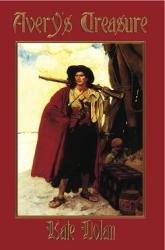
Avery’s Treasure
by Kate Dolan
Zumaya, 2007
ISBN 978-1-934135-66-2 (Paperback), $15.99
New
Providence awaits the arrival of the new governor,
whose mission is to rid the island of the pirates
that infest it. Edward Talbot, captain of the Osprey,
wavers between accepting the king’s pardon and
continuing to go on the account. Charles Vane has
no such dilemma; he is and always will be a
pirate.
Ben Bridgeman sees
only trouble ahead with the governor’s arrival and
insists that his daughter, Arleigh, seek sanctuary
at a convent on a French island. While Edward
ponders whether to accept Ben’s commission,
Arleigh has plans that don’t include living with
nuns. Spoiled and greedy, she dreams of locating
her father’s treasure and escaping his clutches.
Her lack of forethought and planning land her on
Charles Vane’s ship. His quartermaster, Calico
Jack Rackham, discovers her sex and contrives to
obtain the treasure map. When Edward learns
Arleigh has fled, he agrees to go after her
because Ben is really Henry Avery, a retired
pirate who amassed a fortune.
Guilt for pushing
Arleigh to run away pushes Rev. Yam to sign on as
one of Edward’s crew. Things go awry almost from
the start and they end up on an island inhabited
only by a buccaneer’s daughter. Dominique wants
the intruders gone, but when Arleigh ends up on
the island as well, a volatile mixture brews.
Dominique loves Yam, but he only has eyes for
Arleigh. She wants to be free and secure her
father’s treasure. Edward wants the treasure and
to return Arleigh to her father. Their paths to
success are fraught with the unexpected, including
a dangerous encounter with Blackbeard.
Dolan’s research
into the Golden Age of Piracy is evident
throughout this adventure. Pirates abound, and the
imaginary situations that bring those from history
together are realistically portrayed. Arleigh’s
flight is a bit contrived, and her ready
acceptance into Vane’s crew doesn’t quite ring
true. The true heroine is Dominique, and the
melding of her isolation with the world beyond
provides the true adventure and romance of the
story. Arleigh slowly matures into a more likeable
woman once these two women join together to rescue
those they love, and it is only in doing so that
Arleigh learns the true meaning of friendship and
love. Avery’s Treasure is a tale with
serpentine twists and turns where dreams do come
true, but not always in the ways we expect.
Review Copyright ©2007
Cindy Vallar

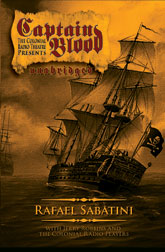 Captain Blood
Captain Blood
by Rafael Sabatini
Blackstone Audio, 2006
ISBN 978-0-7861-6791-3, $55
Presented by The Colonial Radio Theatre
Playing Time: 7 hours on 6 compact discs
Dr.
Peter Blood, a peaceable surgeon who goes to the
aid of a wounded rebel, finds himself on trial
for treason against the English king.
Transported to Bridgetown, Jamaica, Blood
becomes one of Colonel Bishop’s slaves, but
rather than toil in the field, he ministers to
the sick citizens, including the governor. This
incursion into the profits of the two doctors
already on the island causes them to abet Blood
in his attempt to escape the island. A Spanish
raid interrupts their plans; ever resourceful,
Blood and his mates turn the tide on this new
enemy – rescuing the town while capturing a
better ship to begin their lives as pirates.
He names their ship after
Arabella Bishop, the colonel’s niece. In quick
order Blood establishes a reputation among the
brotherhood, but a partnership with another
equally infamous pirate turns to deception and
death. Twice Blood rescues damsels in
distress, but the second one, Arabella, spurns
his love because he is a pirate. He eventually
accepts that fate has dealt him a hand he
never expected, nor wanted, but the ouster of
the Royal House of Stuart and the war between
England and France may just change his mind.
Many years have passed since I
first read Captain Blood after seeing
Errol Flynn bring Sabatini’s character to life
on film. This Colonial Radio Theatre
production is true to the original book, so
listening to them dramatize the novel is like
visiting an old friend. Sound effects make the
action real, while the actors bring the
characters to life, enhancing this historical
romantic adventure that is the epitome of a
swashbuckling tale. Fans of Sabatini will want
to add this to their collections, and those
only familiar with Flynn’s interpretation will
want to meet the real Captain Blood. The price
is steep, but well worth the investment.
Meet the Colonial Radio Theatre
Review Copyright
©2006 Cindy Vallar


Captain Mary, Buccaneer
By Jacqueline Church Simonds
Beagle Bay Books, 2000, ISBN 0-9679591-7-9
When most people think of
pirates, they think of men, but some women
-- Anne Bonny and Mary Read, to name two--
dared to thwart convention by turning to
piracy. Captain Mary is a fictional
composite of these two women, and she is
just as ruthless and daring.
The story
begins in 1721, when Mary is already a
legendary pirate hunted by the navies of
several nations. She commands her own ship
(the Fury), has created a
financial empire, and has established a
safe haven for all pirates on Cache
Island. Freeing a traitorous doctor from a
captured French ship and having an affair
with him complicate Mary’s life. She must
evade the French who hound her, while
keeping her crew from mutinying.
This is a
well-researched tale that paints a harsh
and dangerous way of life. At no point
does the author glorify or romanticize
piracy, a refreshing change from most
pirate tales. Some readers may find the
violence a bit too gruesome. Others may be
uncomfortable with Mary’s choice of
lovers, who also include a former slave
who’s now her pilot and a woman who was a
hostage but now runs an upscale brothel.
This isn’t a story where the reader will
warm up to any of the characters. Captain
Mary, Buccaneer is for those seeking
adventure on a rolling ship, the thrill of
the chase and sea battles between the
hunter and the hunted, or to be pirates in
search of treasure.
Review Copyright ©2001
Cindy Vallar
(This review was originally published in
the May 2001 issue of Historical
Novels Review.)

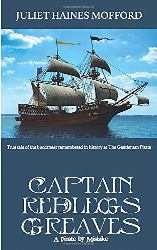
Captain Redlegs Greaves: A
Pirate by Mistake
By Juliet Haines Mofford
Touchstone Press, 2019, ISBN
978-1-946920-67-6, US $16.99
Also available in e-book format
Victors
inflict harsh changes on those who
lose. Such is the fate for more than
7,000 Scots – men, women, and
children – following the Battle of
Worcester in 1651, when they are
transported to Barbados. Although
the law guarantees them light at the
end of seven years, a dead Scot is
far better than a live one and they
are treated so harshly that few of
these exiled Royalists – who become
known as “redlegs” – ever regain
their freedom. This is the tale of
one who did.
The concept of liberty is
foreign to fourteen-year-old Daniel
Greaves, who has only known
servitude, but freedom is a dream
that his father refuses to
surrender. This is why the pair are
on the run when the story opens in
1663. The hope is to get aboard a
ship that will take them to
Scotland. But plantation owners are
notorious for not surrendering
property, especially the cruel and
heartless Reginald Pickett. When
caught, Daniel suffers ten lashes.
His father’s punishment is far
worse, for this is his third escape
attempt, which means he is branded a
fugitive traitor in addition to
being flogged. Infection sets in,
which combined with the loss of
hope, leads to death. Before his
father succumbs, Daniel promises to
one day gain his freedom. He keeps a
low profile, while watching and
waiting for that day to come.
Fortune shines on Daniel
when Pickett sells him to a new
owner. William Chandler, a kind man
in need of an apprentice for his
shipping business. Daniel is treated
more like an adopted son than a
slave, and he becomes adept in his
new trade. As he comes of age, he
falls in love with Clarissa,
Chandler’s daughter. He also
befriends a cabin boy from a
mysterious ship that sometimes
visits the island. Daniel teaches
him to read in exchange for learning
to tie knots. When a tragic loss
leads to debts which leads to more
tragedy, Daniel learns he is to be
sold back to Pickett – a situation
he cannot and will not tolerate.
Left with no other choice, he bids a
poignant farewell to Clarissa, who
promises to wait for him, and flees
the island. The ship on which he
stows away isn’t a merchant ship.
Nor is she bound for Scotland. It is
the cabin boy’s vessel and when the
mean-spirited captain, who is often
drunk, discovers him, Daniel will
either be thrown overboard or join
the pirates.
This biographical novel
tells the story of Captain Redlegs
Greaves, a gentleman pirate who is
an ancestor of the author’s husband.
Greaves has a moral compass that
influences his choices as a pirate
and, eventually, leads him to retire
a rich man, who takes the king’s
pardon. Before then, he finds
himself embroiled in a mutiny,
commanding a pirate ship, facing the
hangman’s noose, experiencing the
sea quake that decimated the first
settlement on Nevis in 1680, and
serving aboard a New England whaler.
The author achieves her
goal of depicting a pirate tale
based on fact rather than romance.
The epilogue reads more like an
author’s note, letting readers know
what happens to Greaves after he
reunites with Clarissa, but fails to
identify what elements of Daniel’s
story are fact and what are fiction.
The reader isn’t always fully
engaged in the story because
information dumps occasionally
interrupt its flow and the dialect
in dialogue is sometimes difficult
to decipher. No explanation is given
as to how Greaves manages to meld
back into society while retaining
his real name throughout his life.
Clarissa also seems to get over her
horror of his piracy too easily.
In spite of these
shortcomings, Mofford’s depiction of
what Greaves endures and how he
overcomes the hurdles he encounters
is commendable. She pulls no
punches, yet entwines a thread of
hope compelling readers to keep
turning pages. The potency of this
tale that makes it intriguing is her
use of a pirate protagonist often
overlooked in histories of Caribbean
piracy. This book may be fiction,
but it is based on facts that have
rarely been shared with others,
which is why it is worth reading.
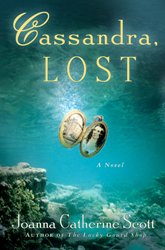
Cassandra, LOST
By Joanna Catherine Scott
St. Martin’s Press, 2004, ISBN
0-312-31942-7, $24.95
Just
before her eighteenth birthday in
1793, Cassandra Owings of Maryland
elopes with a Frenchman of whom her
father disapproves. Benedict van
Pradelles takes his new bride to
France to help his parents flee
Paris. When Cassandra and Benedict
arrive, his mother is too ill to
travel and Benedict must reclaim
their wealth and property in the
country. After escaping the
revolutionists who imprisoned him, a
wounded Benedict returns to
Cassandra, who must now nurse him
and his mother while she herself is
pregnant. Confined to the two rooms
where they live, she feels like a
prisoner within the walls of the
townhouse, for the streets are
unsafe and the servants seem ready
to harm them if given any excuse.
During this time,
Cassandra meets and befriends Jean
La Fitte, a young lad who helps his
father and Benedict in their secret
affairs. Eventually, she joins Jean
in his work, which allows her to
escape from her prison and
experience adventure. Jean’s
father’s arrest and the deaths of
Benedict’s parents force them all to
realize they must leave France or
face the guillotine. When Jean
decides to search for his brother,
Pierre, rather than accompany
Cassandra and Benedict to America,
she gives him a locket with her
picture in it and they promise that
someday they will meet again.
This well-researched novel
about Cassandra and her life in
Paris and New Orleans is based on
fact. Not much is known of her real
life, for she had no contact with
her family after she eloped just
before the boat she boarded
disappeared soon after it sailed in
1815. Whether she had an affair with
Jean Laffite can’t be proven with
any certainty, although he
apparently knew her. Laffite was a
master at illusion and
misinformation, and the author does
a commendable job showing this
penchant for secrecy. She portrays
him as a complex character,
charismatic yet iron willed, traits
necessary to his trade as privateer
and smuggler. She deftly weaves the
facts and legends about Laffite,
providing plausible explanations for
the stories we know of him.
If Jean Laffite were not a
character in this book, would I have
read it? Probably not, for I had
several major problems with the
story. First, much is told rather
than shown to the reader. This
technique keeps the reader at arm’s
length from the action rather than
allowing the reader to “participate”
in the story. Perhaps a greater flaw
is that Cassandra is not a likeable
heroine. She’s childish and
self-centered, and has a skewed
definition of love. She never
becomes more than a one-dimensional
character, whereas Benedict and
Laffite do. Even William Claiborne,
the governor of Louisiana, is better
drawn, although the reader may think
the familial relationship between
Claiborne and Cassandra contrived,
and the author doesn’t confirm in
her author’s note whether they were
cousins or not.
There are several factual
errors in the story, although they
are minor ones. Bluebeard is twice
portrayed as a real pirate when he’s
actually a fictional one. The reader
is left to wonder why the author
didn’t just use Blackbeard as the
pirate in question, as he really
lived and residents of Maryland
would have known of him, for he was
a legend in his own time. The
author’s claim that polite society
didn’t accept Laffite is half right
– Americans didn’t, but Creoles did.
Also, she doesn’t have him deny that
he’s a pirate when Cassandra asks
this of him. In fact, Laffite’s
contemporaries say he vehemently
denied ever being a pirate. Lastly,
the author spells his name as
“Lafitte,” whereas he always signed
his name “Laffite,” as evidenced in
several extant documents.
Review Copyright ©2004 Cindy
Vallar

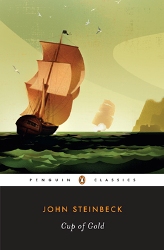
Cup of Gold: A Life of Sir Henry
Morgan, Buccaneer, with Occasional
Reference to History
By John Steinbeck
Penguin Books, 2008,
978-0-14-303945-7, $14.00
Henry
Morgan, a young Welsh lad, craves
adventure. He doesn’t want to be a
farmer like his father, Old Robert.
One night a former helper, Dafydd,
visits. His tales of life at sea in
the Caribbean spur Henry to follow
his dream. Before he slips away, he
climbs the mountain to get Merlin’s
counsel. The old man, who resembles
a Druidic priest, tells him, “You
will come to your greatness, and it
may be in time you will be alone in
your greatness and no friend
anywhere; only those who hold you in
respect or fear or awe.” (23) Henry
considers visiting Elizabeth, but he
is of an age where she is “a thing
of mystery” and fear prevents him
from saying goodbye to her. (25)
In Cardiff Henry befriends
Tim, a seaman who promises to
arrange passage for Henry aboard the
Bristol Girl, for the price
of a meal and four pounds. Henry is
born to walk the decks of a ship and
to feel the ocean spray on his face.
It matters not that he must work in
the galley with the cook, for when
he’s not busy, he learns from the
other seamen. Not until they reach
Barbados does Henry learn he must
serve as an indentured servant to
James Flower, “not a hard man, and
he was certainly not a very
brilliant man.” (62) During this
time, Henry learns the skills and
self-reliance he needs for the
future – the day he will finally
become the great man of whom Merlin
spoke.
Eventually, Henry makes
his way to Jamaica and becomes a
buccaneer. Rumors spread through the
Caribbean of La Santa Roja, a
Spanish woman of fabulous beauty.
When the desire to possess her
overcomes Henry, he raids Panama
(the Cup of Gold), the taking of
which makes him legendary. But is La
Santa Roja what he really wants? And
what of his life once he finally
possesses the dream?
Most American readers are
introduced to John Steinbeck in
English class when they read The
Red Pony and Of Mice and
Men. But how many English
teachers mention that his first
novel was about a pirate? Cup of
Gold isn’t his best work, and
a contemporary reviewer called it “a
rather weird” book. When published
in 1929, some thought the novel was
a biography. Steinbeck did
incorporate some history into the
story, but opted to use a single
source, the English edition of Buccaneers
of America, which contained
“questionable (and damning)
statements about Morgan himself.”
(Morgan sued the publishers for
libel in 1684 and won.)
This isn’t your typical,
modern-day story of pirates. Rather
than a strict historical novel,
Steinbeck opts to pen an historical
fantasy, but fanciful may be a more
appropriate description. It’s very
readable, but anyone expecting the
style of his later works will be
disappointed – that was yet to be
developed when he wrote Cup of
Gold. Eloquence and prose
intrudes into the flow of the story,
yet anyone who has read stories
written in the past should enjoy
this pirate tale. Those who are fans
of Morgan may not find the portrayal
flattering, but Steinbeck chooses
not to place the legendary buccaneer
on a pedestal. His character comes
across as a special, yet ordinary,
man with very human tendencies.
Review
Copyright ©2009
Cindy Vallar


Deep as the Sky,
Red as the Sea
by Rita
Chang-Eppig
Bloomsbury,
2023, ISBN
978-1-63973-037-7,
US $28.99 / CAN
$38.99
Also available
in other formats
The
death of her
husband
surprises Shek
Yeung. Not
because he
dies; that
possibility is
expected when
one is a
pirate. What
catches her
off guard is
that she loved
him. After
all, he’s the
one who stole
her from her
life as a
prostitute to
live and prey
upon the sea.
His death
complicates
her life. She
commands half
the Red Banner
Fleet, but
everything now
belongs to her
husband’s
“adopted” son
and lover,
Cheung Po. Her
husband’s
death also
puts the
pirate
alliance on
wary footing.
If she wishes
to maintain
control and
her freedom,
there is only
one option:
she and Cheung
Po must marry.
Despite their
age
differences
and outlooks
on life, Shek
Yeung and
Cheung Po do
wed. Theirs is
a fragile
alliance, but
one that is on
surer footing
than the
confederation
of pirate
fleets. Kwok
Po-Tai of the
Black Banner
is the biggest
threat and
Cheung Po
doesn’t trust
him since the
man dislikes
sharing sea
space with the
Red Banner.
Kwok Po-Tai is
also jealous.
Once her late
husband’s
protégé, he
found himself
displaced by
Cheung Po.
Choy Hin of
the Blue
Banner has
close ties
with Cheung Po
but is also
addicted to
opium. He’s
too easily
swayed by his
wife, who
believes
everything her
English
contacts
share,
especially if
they pertain
to her most
hated enemy,
the Dutch. The
only way they
will continue
to rule the
seas is if the
Red, Black,
Blue, Green,
and White
Banners stay
united. If
not, the
imperial
forces will
win.
In addition to
her concern
about the
alliance, Shek
Yeung believes
there is at
least one spy
among them.
Then news
comes that the
Chinese
emperor has
chosen a new
leader to wipe
out the
pirates. Pak
Ling, known as
the Emperor’s
Sword,
successfully
suppressed the
rebels in the
north. He is
smart, crafty,
and determined
– a formidable
enemy who uses
many
strategies to
defeat his
foes. The
failure of the
White Banner
to meet up
with the Blue
is also
worrisome. As
is
intelligence
learned from a
Dutch captive
about a pact
between
European
enemies and
the Chinese
emperor.
Although
loosely based
on Zheng Yi
Sao, this
novel is not
historical
biographical
fiction.
Instead, it
shadows what
is known of
the real
pirate while
offering
unique and
provocative
circumstances
to make Shek
Yeung a
compelling
character
shaped by life
experiences.
It is also a
story of
survival and
knowing when
to hold and
when to fold.
The author
successfully
entwines
history, myth,
and fiction
into an
intricately
woven tapestry
that vividly
recreates time
and place.
Review
Copyright ©2023
Cindy Vallar

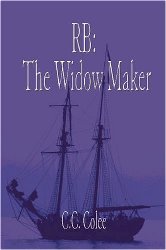  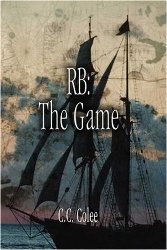
The
Widow Maker
By
C.C. Colee
America
House, 2001,
ISBN
1-58851-378-5,
US $25.95
The Enchantress
By
C.C. Colee
America
House, 2000,
ISBN
1-59129-065-1,
US $34.95
The Game
By
C.C. Colee
Publish
America, 2003,
ISBN
1-59286-135-0,
US $24.95
After
her parents’
deaths, Audrey
Malone lives
with her
uncle. He’s
determined to
make a good,
and
profitable,
match for her
regardless of
her thoughts
on the matter.
His final
choice leaves
Audrey with
little choice
-- submit to a
brutal and
unhappy
marriage, or
run away. She
opts for the
latter and
ends up aboard
a ship bound
for Africa and
“rescued” by
pirates. This
is the premise
of The
Widow Maker,
the first
book in the RB
trilogy.
Audrey becomes
the property
of Captain
Rene Black,
but she falls
in love with
his
quartermaster,
who protects
her from Black
and other
pirates up to
no good.
Book two, The
Enchantress,
finds Audrey
aboard another
pirate ship,
captained by a
woman, after
the Royal Navy
destroys
Black’s ship.
Captain Mala
and Audrey
think Black is
dead, but he
resurfaces and
takes over
Mala’s ship,
which causes
more problems
for Audrey. He
brings with
him a
particularly
nasty pirate
intent on
raping Audrey.
In the
meantime,
Mala’s
quartermaster
attempts to
convince Mala
that only he
truly loves
her. All this
turmoil
inevitably
leads to many
showdowns,
sometimes with
tragic
results. The
final book, The
Game,
involves
Black’s
attempts to
locate Mala
before his
arch nemesis,
Captain
Alexander of
the Royal
Navy, carries
out his
threats
against Mala.
Unlike many
series, this
trilogy
requires
readers to
begin with
book one and
continue to
the end. The
individual
titles do not
stand alone.
Nor is this
typical
romance, for
there is far
too much
domestic
brutality and
darkness, even
though love is
an underlying
theme
throughout the
books. Readers
looking for
pirate
adventure will
find this
trilogy fits
the bill.
While it
provides a
more accurate
depiction of
pirates and
life at sea
than many
novels, there
are still some
historical
inaccuracies.
The Widow
Maker is
the most
absorbing of
the three
books, and
ensnares the
reader into
finding out
what happens
to Audrey and
the other
characters,
which are all
well drawn and
easy to
envision.
Audrey matures
from timid
lady to daring
pirate by the
end of the
series.
Unfortunately,
there are
several
drawbacks of
which readers
should be
aware. The
Widow Maker
and The
Enchantress
are poorly
edited. This
isn’t a major
problem in the
first book,
but the second
is too long
and includes
too much
repetition of
incidents,
which may
annoy the
reader. While
The Game
is better
edited, the
suspense and
tension in
rescuing Mala
never succeeds
and is over
far too soon.
This leaves at
least a third
of the book
devoted to
tying up loose
ends. It is
also the least
accurate
historically,
which may
leave the
reader feeling
cheated or
disappointed
after reading
all three
books. In
light of these
problems,
readers may
find the high
prices of
these books a
deterrent.
Review
Copyright ©2004 Cindy
Vallar

 Kingston
by Starlight
Kingston
by Starlight
by Christopher John Farley
Three Rivers Press, 2005, ISBN
1-4000-8245-5, US $13.95 / CAN $21
Since her first
appearance in A General
History of the Robberies and
Murders of the Most Notorious
Pirates by Captain Charles
Johnson in 1724, Anne Bonny has
intrigued people interested in
Caribbean piracy. Not only was
she a female pirate, but she
also disappeared from a Jamaican
jail, never to be heard from
again. In Kingston by
Starlight, Anne tells her
own story from her childhood in
Ireland to her pirating days
with Calico Jack Rackham and
Mary Read to their capture and
her life after prison.
One startling
difference between this novel
and others is the lyrical
language and literary tone of
the book. Most recent novels
portray pirate life with more
realism and grittiness. While
essential elements of Anne’s
story lay the foundation for
this novel, the author
interprets her life story
differently from what readers
may remember. For example, Bonny
is not Anne’s last name
originally. She is Anne Cormac
until she married James Bonny,
but he never appears in this
story. Some readers may object
to the sexual elements; others
may find themselves kept at
arm’s length from Anne rather
than being at her side as events
unfold. Readers who favor
literary books and the lilt of
poetry should enjoy Kingston
by Starlight.
Review
Copyright ©2005
Cindy Vallar

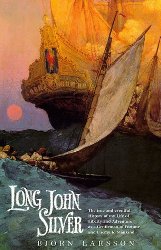
Long John
Silver
by Bjorn
Larsson
Harvill Press,
2001, ISBN
978-186046539
reviewed
by Irwin Bryan
When
you hear “Long
John Silver,”
in your mind’s
eye you
picture a
one-legged
pirate.
Larsson’s tale
(Silver’s
“autobiography”)
begins with
the story of
how he lost
that leg and
the events
surrounding
it.
Silver is
painted as a
feared and
fearless
person.
Perhaps his
most ruthless
act ends this
part of the
story.
After this
preface, the
story begins
anew during
Silver’s
childhood in
Bristol. We
meet a young
lad who gets a
good
education,
complete with
learning
Latin. A
confrontation
with the only
person he ever
fears, his
parson, sends
him running to
the docks and
the start of
his seafaring
life. He is
determined to
learn his new
trade well and
is devoted to
his ship. The
inner workings
of his
superior mind
are laid bare
to readers,
who already
know he ends
up as a
pirate, but
have no idea
how or when he
makes that
transition.
First, a few
other
adventures in
Silver’s life
show him
capable of
loyalty and
even
compassion and
love. These do
seem a bit
drawn out and
only the
future
references to
Treasure
Island and
Captain Flint
give the
reader
motivation to
continue.
By the time
Long John’s
story takes
him to his
piratical days
with Flint and
then Jim
Hawkins,
Silver the
“author” is
aged to the
point where
he’s not sure
he’ll be able
to finish his
tale and
things get
jumbled up and
interlaced
with the story
of events that
come later.
Finally, with
his story
complete, he
talks of his
final days and
his life of
enforced ease.
All in all,
Larsson’s
novel seems
plausible, but
it bogs down a
few times and
isn’t as
entertaining
as Edward Chupack’s
autobiography
of Silver,
which is much
more
action-packed
and deals more
with Silver
the pirate.
Review
Copyright
©2012
Irwin Bryan

 MacHugh
and the Faithless Pirate
MacHugh
and the Faithless Pirate
By William S. Schaill
Fireship Press, 2015, ISBN
978-1-61179-357-4, US
$18.00
e-book ISBN
978-1-61179-358-1, US
$6.99
In
the midst of a wintry
blizzard in 1694, Robert
MacHugh breaks into the
warehouse of the richest
man in New York Towne.
Doing so is not what the
respected wine merchant
and fourth son of a
Scottish baron should be
doing, but he seeks
proof that Frederick
Phillipsie is in league
with William Archer, a
cruel pirate who’s been
plundering Robert’s
cargoes.
Although
his suspicions are
confirmed, there is
nothing Robert can do
until a captain of the
Marines delivers a
letter from Lord John
Churchill. The missive
outlines attacks Archer
has made on property of
the Grand Moghul of
India. The pirate also
raped the moghul’s
daughters, which has
caused diplomatic
problems for the king
and queen and the East
India Company (EIC). In
retaliation for Archer’s
vicious plundering, the
moghul has taken EIC
officials hostage and
issued an ultimatum.
England has nine months
to deliver proof of
Archer’s death to the
moghul, or the hostages
will be killed. One
captive is Robert’s
youngest brother.
There are
several caveats to
hunting down Archer.
Robert must not
interfere with Archer’s
financial backers in any
way since these men,
like Phillipsie, wield
great influence and
power that the monarchs
need. Also, the captain
of the Marines and a
reformed pirate who once
sailed with Archer are
to accompany Robert on
this trek.
With a
cargo meant to lure the
pirate from his lair,
Robert and his
companions set sail for
the Caribbean. Finding
Archer takes time, for
no one is certain where
he is and the West
Indies has many ideal
places where he can
shelter. Complicating
the hunt are foul
weather, French
corsairs, a lovely woman
whose father is in
cahoots with the
pirates, murder,
uncooperative officials,
and a Royal Navy
commander who bristles
at being under Robert’s
orders. Nor are the two
warships sent to aid in
the search the "powerful
cruisers" Churchill
promised. When one
disappears, Robert is no
longer certain he can
succeed in his mission
and save his brother’s
life.
While the
opening scene of this
story contains
spine-tingling action
that makes the reader’s
breath catch, the
purpose for its
inclusion is vague since
Phillipsie never appears
in this story and his
interactions with the
pirates are never
depicted. There are
occasions where it’s
difficult to keep track
of who’s who and there’s
a tendency to refer to
characters in ways that
distance the reader from
the story. Better
proofreading, less
awkward phrasing of some
sentences and, since
time is of the essence,
inserting more tension
in some scenes would
benefit the story. In
spite of these flaws, MacHugh
and the Faithless
Pirate
incorporates gripping
action scenes that whisk
the reader into the
midst of fierce storms,
pirate chases, and
perilous battles.
Meet
the author
Review
Copyright ©2015
Cindy Vallar

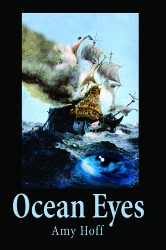
Ocean Eyes
By Amy Hoff
Writers Club
Press, 2001,
ISBN
0-595-18723-4,
US $16.95
Sir
Joseph Bruce
is a Scot in
the English
army during
the struggle
between the
Royalists and
the Puritans.
His closest
friend is an
Englishman
named Anders,
a man noted
for his
dalliances
with women.
Joseph prefers
to write
poetry until,
one night in a
tavern, he
meets an
exotic dancer
who turns out
to be the
notorious and
legendary
Captain Angel
d’Auteville, a
bloodthirsty
pirate unlucky
in love. When
his countrymen
intend on
betraying
Charles I,
Joseph and
Angel form an
alliance to
safeguard the
king. Joseph
almost dies
while Angel
and her men
leave
empty-handed.
Thinking
Joseph dead,
Angel returns
to her wicked
life after a
brief respite
with friends
in Ireland. A
disillusioned
Joseph turns
his back on
his military
career,
befriends a
historian
rumored to be
a vampire, and
returns home.
After some of
Angel’s men
betray her to
the Spanish
Inquisition,
those who
remain loyal
set out to
find Joseph,
for they
require his
assistance to
affect her
rescue.
Ocean
Eyes is a
compelling
novel that
doesn’t
embellish or
romanticize
piracy. The
characters and
their foibles
draw the
reader into
the story.
Joseph has
trouble coming
to terms with
both his royal
heritage (his
ancestor is
Robert the
Bruce) and
loving a woman
who walks on
the wrong side
of the law,
but time and
again events
force him to
overcome these
uncertainties.
Past lovers
have jaded
Angel where
men are
concerned, and
her anger is a
driving force
behind the
viciousness
that makes her
legendary. It
is Joseph’s
memory that
sustains Angel
during her
torturous
imprisonment.
A multitude of
secondary
characters
spices this
story that
circumnavigates
the globe.
Beware, the
ending is
fitting but
will haunt the
reader long
after the
final page is
turned.
Review
Copyright
©2005 Cindy
Vallar

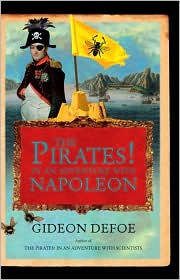
The Pirates!
In an
Adventure with
Napoleon
by Gideon
Defoe
Pantheon
Books, 2008,
ISBN
978-0-375-42398-7,
US $16.95
E-book ISBN
978-0-307-37826-2,
US $16.95
A
shoe-in for
the Pirate of
the Year
Award, at
least in his
opinion, the
Pirate Captain
is desolated
when he loses
to a younger
upstart who
hands out
calling cards.
There’s
nothing left
but for the
Captain and
his crew to
become
beekeepers,
and the
perfect place
for this is
the island of
St. Helena,
according to
Black Bellamy,
who likes to
put one over
on his fellow
buccaneers –
and this time
is no
exception.
Much
to the chagrin
of Jennifer
and her fellow
mates, they
are unable to
dissuade their
Captain from
leaving a life
of plundering.
But St. Helena
isn’t exactly
the
picture-perfect
island Bellamy
promised.
Undeterred,
the Captain
becomes a
beekeeper and
hosts parties
everyone
attends
because he’s
the biggest
celebrity
their little
island has
seen in quite
some time. At
least he is
until an
officer in the
Royal Navy
knocks on the
Captain’s door
and presents
the newest
resident,
Napoleon
Bonaparte.
The little
island can’t
support two
enormous egos,
and it isn’t
long before
the Captain
and Napoleon
try to outdo
each other.
While those
two battle it
out, the other
pirates are
desperate to
find a way to
return to
their old way
of life.
Convincing the
Captain of
that, while
he’s trying to
run against
Napoleon to be
head of the
St. Helena
Residents’
Association,
may prove a
tougher
challenge than
anyone thinks.
It’s rare for
me not to know
what to write
about a book,
but this one
definitely
falls outside
the norm. It’s
part
tongue-in-cheek,
part
whimsical, and
part silly,
and each
chapter
outdoes the
one before. In
spite of this,
the story
works and
matters do get
resolved.
Don’t expect
the blurb on
the back of
the book to
prove helpful.
It has nothing
to do with
this
particular
story. The
third in The
Pirates!
series, this
book is for
adults who
want a
fast-paced,
humorous read
that reminds
them of being
a kid.
Review
Copyright
©2009 Cindy
Vallar

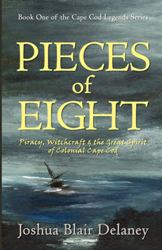
Pieces of
Eight
By Joshua
Blair Delaney
Infinity,
2011, ISBN
978-0-7414-6479-8,
US $24.95
In
1715 Eastham,
Calvinism
retains a
powerful hold
over the
residents.
They fear the
unknown and
those who
stray from the
strict
standards
governing the
village. This
trepidation
comes to a
boil when
three people –
a stranger
washed ashore
after a storm,
a girl who
dreams of the
future, and a
Nauset who
holds to the
traditions and
beliefs of his
people – cross
paths on
colonial Cape
Cod.
Rather
than submit to
further abuse
from the
captain of a
merchant ship,
Samuel Bellamy
jumps
overboard. He
washes ashore,
where he is
taken care of
by John
Julian, one of
the native
people of the
island.
Eventually, he
seeks
employment in
Eastham, but
few will
employ him,
and he lacks
sufficient
funds to marry
Maria Hallett,
a local girl
with a kindred
spirit. When
he crosses
paths with
Palsgrave
Williams and
learns of a
fleet of
Spanish
treasure ships
wrecked off
the Florida
coast, he
joins
Palsgrave’s
expedition to
salvage some
of the gold.
Others have
similar
notions and,
before long,
Sam and
Palsgrave
decide if they
wish to gain a
fortune, they
must turn
pirate.
Maria
Hallett
mistakenly
tells others
that she
dreamt of her
father’s death
before news of
it reaches
Eastham. Ever
since,
whispers of
witchcraft
have
circulated in
spite of her
weekly
attendance at
Sunday
service. One
reason for
this is that
Maria has a
wandering
soul, one that
longs to visit
far off places
– a dream no
Puritans in
the village
understand,
including her
mother and
stepfather.
When she seeks
out an elderly
widow who
lives alone
and has
knowledge of
plants that
can heal
people, Maria
again falls
under
suspicion of
witchcraft.
Such
ungodliness is
further
supported when
it becomes
known that she
has slept with
Bellamy.
John
Julian spends
a lot of time
locked in the
pillory
because of his
refusal to
follow the
Puritans’
faith. With
his parents
dead and his
own people
viewing him as
someone to be
shunned, John
spends much of
his time
alone. He
works for a
local
smuggler, who
eventually
agrees to sell
him land,
where he hopes
to bring other
tribal members
to live and
practice the
ways of their
ancestors. The
elders of
Eastham refuse
to honor his
ownership of
the land,
which renders
John’s deed
invalid and
leaves him
without
purpose to his
life.
My
reservations
about this the
book stem from
the manner in
which the
author chooses
to tell the
story. After
reading the
prologue,
where the
three primary
characters are
introduced in
separate
scenes, I
expected the
author to
interweave
their stories.
Instead, each
is told
separately:
The Tale of
Goody Hallett,
The Tale of
John Julian,
and The Tale
of Sam
Bellamy. This
style of
storytelling
can prevent a
reader from
becoming fully
involved in
the book,
which is what
happened for
me, especially
at the
critical phase
in each
character's
life. The
occasional
insertion of
minor
characters’
viewpoints
provides a
more rounded
glimpse into
this time and
place, but
also draws out
the story,
which weakens
the power of
the final two
parts of the
book where
Maria, Sam,
and Julian’s
stories
intersect.
In
spite of this
personal
proviso, Pieces
of Eight
is a unique
recasting of
the popular
Cape Cod
legend.
Delaney’s
intricate tale
melds fact
with fiction
to recreate
colonial
times. He
deftly
demonstrates
how religion,
fear, and
prejudice come
together in
constructive
and
destructive
ways with
profound, and
sometimes
tragic,
outcomes. I
enjoyed this
recounting of
Sam and
Maria’s story,
and
appreciated
the
introduction
of John Julian
as more than a
side note in
history books.
Review
Copyright
©2011 Cindy
Vallar


Pirates of the
Delaware
By Rupert
Sargent
Holland
Schiffer,
2006, ISBN
0-7643-2487-X,
US $14.95
A
bored student.
A beautiful
émigré. A
mysterious
Englishman. A
sinister
stranger.
These four
people come
together on a
lovely spring
day, setting
in motion an
adventure of
highwaymen,
smuggling,
piracy, and
revolution.
Jared Lee
studies law
under
Nathaniel
Carroll, a
respected
lawyer who
tends to talk
about
situations
rather than
becoming
involved in
them. Fleeing
France, Jeanne
de Severac and
her father, a
marquis,
arrive in
Philadelphia
with few
possessions.
With Mr.
Carroll and
Jared’s
assistance,
she sells a
necklace to
provide her
father with
necessary
funds. When
the Severacs
move to a
questionable
country
estate, Jared
seeks out his
friend, Hal
Norroy, an
Englishman
with secrets,
for advice
because he’s
more worldly
than a
farmer’s son.
Jared’s
first hint at
possible
danger comes
when a
rough-looking
Frenchman
attempts to
accost Jeanne
on her arrival
at Mr.
Carroll’s
office. A
highwayman
holds up Jared
after he
leaves a
party. When
the Severacs’
servant
arrives to
deliver a
message to
Jared, they
discover
Jeanne’s note
has
disappeared
from the man’s
pocket. Jared
makes
arrangements
to meet with
Jeanne
secretly, but
is kidnapped
by pirates on
the way to
meet her.
While
imprisoned at
a farmhouse,
his friend,
Luke Hatch,
arrives and,
using his
boxing
prowess,
disables the
man holding
Jared.
Together they
escape, only
to discover
the coach
carrying
Jeanne and her
father to a
new residence
in
Philadelphia
has
disappeared.
Intent on
rescuing them,
the two men
soon find
themselves
aboard a
pirate ship,
where the
captain’s
identity stuns
them. If that
isn’t enough
trouble to
have to get
out of, some
pirates are
planning to
stage a
mutiny!
Originally
written in
1925, this
mysterious
adventure
takes place in
1793. While
the thrills
and suspense
aren’t the
edge-of-your-seat
type and the
pirates don’t
appear until
near the end
of the tale,
this book has
many
serpentine
twists that
require the
reader to pay
attention to
detail.
Holland
manages to
weave his tale
with history
without
throwing it in
the reader’s
face. Pirates
of the
Delaware
begins slowly,
just as any
warm, spring
day invites us
to toss aside
our work and
enjoy the
outdoors, but
the first hint
of danger soon
spurs us to
join Jared in
piecing
together the
puzzle even if
danger lurks
around the
corner.
Review
Copyright ©2009
Cindy Vallar


The Sweet
Trade
By Debrah
Strait
Smashwords,
2013, e-book
ISBN
9781301798490,
US $6.95
Createspace,
2013, print
ISBN
978-1492816409,
US $14.95
One
morning in
1653, Dirk van
Cortlandt’s
life turns
upside down
when Spaniards
invade the
Dutch Isle of
Bentyn. At
eleven years
old, he dreams
of adventure
and he and his
four friends –
Mic (12),
Baldric (9),
and twins Jan
and Joost –
are away
playing
pirates, but
race home to
warn their
parents. By
the time they
arrive, it’s
too late.
Their mothers,
fathers, and
siblings lie
dead or are
slaughtered
while the boys
watch. They
themselves
barely escape
with their
lives aboard a
boat that
washed up on
the island
earlier.
Guilt
plagues Dirk.
His youngest
sister had
caught him
sneaking out
of the house
and wanted to
go with him,
but he said
no. Now,
little Anneke
is dead, and
her murder
haunts his
thoughts and
dreams.
Although
the boys
intend to go
to Curaçao,
they become
lost at sea.
Eventually,
they are
rescued by
French
pirates, who
offer them a
safe haven,
but actually
have something
else in store
for the boys.
The life they
imagined as
pirates is far
different in
reality. Their
“saviors”
haven’t
captured any
prizes of
significance,
so they sail
to Tortuga and
sell the boys
into bond
slavery.
Before they
separate, the
boys vow to
reunite in
seven years at
the end of
their
indenture.
Alone
for the first
time in his
life, Dirk
serves a
buccaneer, an
abusive man
who hunts beef
and smokes the
meat to sell
to traders and
pirates. It is
a hard life,
but Dirk
learns the
trade. But
even here the
Spanish hunt
and slaughter
the
buccaneers,
some of whom
befriend Dirk.
He endures his
master’s
beatings until
he grows
taller and
stronger.
Seeking
revenge comes
with
consequences;
rather than
the death he
expects, he is
sold once
again – this
time to four
men who teach
him new
skills.
By
the time the
seven years
have passed,
Dirk has
acquired all
but one skill
needed to
become a
pirate:
leading men.
Aside from
reuniting with
his friends,
one driving
force rules
his life. He
vows vengeance
on all
Spaniards. The
pirate crew
they join
knows only one
way to attack
and,
eventually,
their victims
learn to
thwart their
tactics. After
Dirk rescues
the pirates
from one
failed
escapade, they
elect him as
their captain.
Being their
leader comes
with its own
baggage. As
time passes,
he and his
friends cross
paths with the
most sadistic
of the
pirates,
François
L’Olonnais,
and the most
successful,
Henry Morgan.
This
novel spans
seventeen
years from the
Caribbean to
New Amsterdam.
There are two
interludes of
romance, one
with a distant
relative of
Dirk’s and the
other with the
last person he
ever expects
to fall for. I
enjoyed this
book, although
I felt several
times the pace
slows too
much. While
the majority
of the story
unfolds from
Dirk’s point
of view, a few
times a scene
unfolds from a
minor
character’s
perspective. I
found this
technique
jarring and
oftentimes
thought the
important
information
that’s
revealed could
have been done
without
shifting the
point of view.
Introducing a
second major
character in
the last
chapter also
bothered me,
and their
attraction for
each other
doesn’t ring
as believable
for me as it
should. But
these are
personal
preferences
and not all
readers will
agree with me.
Strait’s
depiction of
life as a boucanier
is
spot-on, and
she never
sugarcoats the
danger and
hard life they
and the
pirates
endured as
they prowled
the seas and
raided Spanish
settlements.
She does a
wonderful job
with her
portrayal of
L’Olonnais and
his final
days, as well
as with her
depiction of
the explosion
aboard
Morgan’s Oxford.
Review
Copyright ©2014
Cindy Vallar

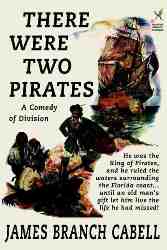 There
Were Two Pirates
There
Were Two Pirates
By James Branch Cabell
Wildside Press, 2003,
ISBN 1592240836, US
$15
Each
year Florida
celebrates José
Gasparilla, King of
the Pirates, who
established his
kingdom on
Gasparilla Island
toward the end of
the 18th century.
Legend says he was a
Spanish naval
officer who turned
to piracy. He was
reputed to have
captured and sunk
thirty-six ships in
eleven years,
amassed a fortune in
treasure, murdered
seamen who refused
to join his ranks,
and imprisoned the
women passengers
(including a Spanish
princess, who was
eventually
murdered). Rather
than face capture by
an American warship,
he wrapped the
anchor chain around
himself and jumped
into the sea.
Whether José
Gasparilla ever
lived or not is a
mystery. In
1946, James Cabell
published this
fantasy adventure
purportedly based on
Gasparilla’s
diaries.
Love
for a woman and a
lack of wealth
convince Gasparilla
to become a pirate
with the solitary
goal of amassing
sufficient funds to
wed Isabel and
retire to a cozy
villa to raise many
children. As he
nears his goal, he
faces the problem of
how to return to
society now that
he’s a wanted man.
Then he captures the
Santa Clara.
Aboard is an elderly
gentleman who
suffers from
rheumatism: Don
Diego, Isabel’s
husband. Don Diego
offers Gasparilla a
way to achieve his
dreams and, after
careful
negotiations, the
deal is sealed.
Gasparilla will
become an honorable
citizen and marry
Isabel, but how?
The
subtitle of this
book is “A Comedy of
Division,” yet there
is little humor in
the story.
Gasparilla is
egotistical to a
fault, yet naively
unaware of how he
affects others’
lives, especially
those women who have
the misfortune to
cross his path.
There is little
action in this tale;
instead, Gasparilla
recounts his
motivations and
experiences. Fans of
Gasparilla and
fantasy will enjoy
this tale, but for
pirate aficionados
seeking a rousing
adventure, I
recommend looking
elsewhere.
Review
Copyright ©2004
Cindy Vallar

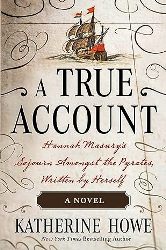 A True
Account
A True
Account
Hannah Masury’s
Sojourn Amongst the
Pyrates, Written by
Herself
by Katherine Howe
Henry Holt and
Company, 2023, ISBN
978-1-250-30488-9, US
$28.99 / CAN $38.99
A
hanging is a
momentous affair.
Especially when the
execution is of a
pirate. William Fly,
no less, a totally
unrepentant sinner.
Everyone will be
there . . . well,
everyone but Hannah
Masury. She’s been
forbidden to go by
her employer, but
Hannah doesn’t
necessarily heed
what she’s told.
When Hannah finally
returns to the
tavern’s stable
where she sleeps,
she finds it
occupied by a young
lad. He claims to be
Billy Chandler and
he’s hiding because
everyone wants him
dead. He even shows
her the black spot
that marks him for
death. She’s not
fully convinced that
he tells the truth
until after they
head for the tavern
to get some food
while everyone else
is asleep. But they
become separated.
She hears a gravelly
voice and an odd
sound before she
stumbles upon
Billy’s dead body.
Then her name floats
through the fog. If
she wants to live,
she has only one
chance: don male
attire and pretend
to be Billy. He
planned on shipping
out on a schooner as
a cabin boy, which
provides her with
the means and
opportunity to
escape before the
pirates catch her.
As they say, the
best laid plans
don’t always work
out exactly as one
hopes, and she finds
herself aboard the Reporter
whose captain
spends most of his
time drunk in his
cabin and the first
mate is none other
than Edward Low.
Travel forward in
time from 1726 to
1930. Professor
Marian Beresford
teaches history at
Cambridge College in
Boston. One of her
students, Kay
Lonergan, has come
across a handwritten
diary from two
centuries ago.
Marian is skeptical
about its
authenticity, but
there’s something
compelling about the
journal. The more
she reads, the more
she questions her
initial findings.
She decides to visit
her father, an
esteemed historian,
in New York and get
his opinion. He
concurs with her
initial assessment .
. . but even a slim
chance of it being
real is sufficient
for the trio to
persuade the
Explorers Club to
finance a trip to
find the pirate
treasure that Hannah
Masury writes about
in her diary. Just
imagine the glory
that such a find
will bring with it.
Marian may finally
prove herself worthy
of following in her
father’s footsteps.
In the meantime, Kay
wants to go for
another reason . . .
publicity. She
thrives on getting
her name in the
spotlight, and so
she joins them on
their grand
adventure.
The past and present
are interwoven in a
seamless tapestry
that contrasts
Masury’s life with
Beresford’s. Marian
also compares who
she is now with who
she was when she was
Kay’s age, as well
as measuring her own
choices and career
with that of her
father. Howe
provides an accurate
depiction of Ned
Low’s brutality as a
pirate and hints at
the fact that he
didn’t start out
being that way. The
story is also rife
with pirate tropes.
Pirate life and
behavior is
realistically
portrayed, although
I found it
interesting that
Marian’s father
cites The
Pirates Own Book
as being the source
he uses as proof
that the journal is
a fake. (This
19th-century volume
includes falsehoods
as well as truths
much like the
pirate-age
contemporary
resource, A
General History of
Pyrates.)
Two words are key to
whether this story
works: “plausible”
and “probable.”
Women did masquerade
as men and did
become pirates, but
how likely was it
for one to join the
crew of Ned Low?
While I think the
answer improbable,
Howe weaves her tale
with enough
believability to
make Hannah’s story
plausible. The
entwining of past
and present
strengthens that
belief, while the
themes of betrayal,
humiliation, and
proving oneself are
universal and
transcend time.
Review
Copyright
©2023
Cindy Vallar

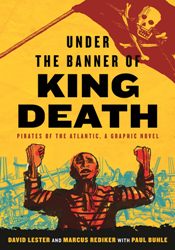 Under the
Banner of King Death:
Pirates of the
Atlantic, a Graphic
Novel
Under the
Banner of King Death:
Pirates of the
Atlantic, a Graphic
Novel
by David Lester and
Marcus Rediker with
Paul Buhle
Beacon Press, 2023,
ISBN
978-0-8070-2398-3, US
$17.95 CAN $23.95
A crowd
gathers in Boston in
1720. An unrepentant
pirate is to hang.
His last words are
to shipmasters,
warning them to
treat sailors
honestly and
decently. After the
execution, John Gwin
and Ruben Dekker go
to an inn where they
are joined by a
stranger who buys
them drinks. Some
time later, they
awaken from a
drugged sleep aboard
a ship of the Royal
African Company
bound for Sierra
Leone.
Forced
to work under a
tyrannical captain
who favors the lash,
John is soon
punished. Later,
others reveal
similar scars and
talk about the only
remedy – rum. That
stirs memories of
his own journey from
Africa to the
Caribbean aboard a
slave ship. He tells
Ruben that he later
escaped his bonds
and sailed with the
pirate Stede Bonnet.
Once
their ship
disembarks their
cargo in Port Royal,
the crew celebrates
in a tavern. Talk of
becoming pirates
plants the seeds of
mutiny. Another
unjust and brutal
punishment on the
way to New York
causes the sailors
and some Africans to
rise up against
Captain Skinner.
They elect John as
their captain, a
sailor named Mark
Read as their
quartermaster, and
go on the account.
John asks the
Africans where they
would like to go and
the decision is made
to sail back to
Sierra Leone to
attack the RAC fort
there.
The
more successful they
are in their
piratical endeavors,
the more incensed
those back in London
become. They finally
decide that the
pirates must be
brought to justice.
They hire pirate
hunter William
Snelgrave. He may be
an experienced sea
captain, but he may
not be as adept at
pirate hunting as he
thinks, for he soon
finds himself a
prisoner of the very
pirates he seeks.
Under
the Banner of King
Death is a
graphic novel based
on Marcus Rediker’s
nonfiction pirate
study entitled Villains
of All Nations.
In the foreword,
Redicker explains
“Why We Need
Pirates,” and shows
how the myths
surrounding pirates
are based on truth
that is far more
compelling than
Hollywood’s
depictions of
pirates. Paul Buhle
pens the afterword,
“Pirates We Have
Seen: Footnotes from
Popular Cultural
History” that
discusses the
current
reinterpretation of
pirate history and
how pirates have
been depicted in
comics.
The
book includes a
historical timeline
of the Golden Age of
Piracy and a
glossary of
eighteenth-century
vulgar speech found
within the book.
There is even a
cameo appearance by
Bartholomew Roberts.
Since
this is fiction,
it’s permissible for
the authors to take
liberties with some
persons from
history. Some
readers, however,
may find this
disconcerting since
the book is supposed
to be a realistic
portrayal of
pirates. Snelgrave
(a pirate captive,
but not a pirate
hunter) and Read
(whose history and
demise are
well-known) could
easily have been
given fictional
names to make them
more believable
characters. Equally
curious are the use
of occasional terms
that do not fit the
time period
(“paramilitary” for
example); having a
native of the Cayman
Islands be familiar
with Robin Hood; and
interrupting the
story to show
pictures of weapons,
medical and sailing
implements, and
food.
The
most compelling part
of this novel is the
stark and concrete
black-and-white
artwork. They depict
the grim reality
rather than an
idealized version of
pirates. The story
is also realistic in
depicting how
sailors were
treated, what drove
them to turn pirate,
and why they were
willing to die to
live a short, but
merry, life.
Review
Copyright
©2023
Cindy Vallar

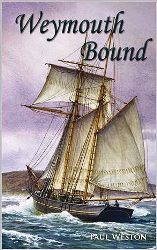 Weymouth
Bound
Weymouth
Bound
by Paul Weston
Independently
Published, 2022, ISBN
9798410209007, US
$10.71 / UK £7.99
Also available in
e-book format
Jack
Stone has a dream.
He wants to be a
sailor, to travel
the seas in search
of adventure. His
father, a fisherman
and smuggler, wants
Jack away from the
dangers of illegally
trafficking goods.
To that end, he
arranges for Jack to
apprentice for seven
years with the
captain and part
owner of the Cicely,
a merchant ship that
carries cargo from
one port to another.
May
1800 finds Jack
learning the ins and
outs of Cicely and
seafaring. With the
keen eyes of a
youth, he often
finds himself aloft
as lookout. He gets
on with most of the
crew, but the one
man to steer clear
of is the mate,
Dennis Vasey. Rumor
has it that he
frequents opium dens
and he’s got a
temper. His father
is part owner of the
ship, so the captain
cannot fire him. Nor
does Vasey do much
even when he is
aboard.
One
evening, while the
rest of the crew is
ashore, Jack remains
aboard. He’s aloft
watching the stars
and the area around
the ship when he
spies Vasey nearing
the ship. His
movements are
furtive, as if he
doesn’t wish anyone
to know he’s around.
Terrified of the
mate after almost
dying because of one
of his orders, Jack
remains hidden. Soon
after Vasey comes
onto the Cicely,
he’s joined by a
stranger. He’s even
more scary,
especially since he
wears a coat of the
Royal Navy and has a
scarred scalp. Jack
knows he should tell
the captain, but he
holds his tongue.
Doing so turns out
to be extremely
dangerous, not only
for the crew, but
also for England.
Jack is the only one
who can remedy his
silence to warn his
homeland and the
king before it’s too
late.
Weymouth
Bound is an
alluring tale that
slowly weaves its
spell on the reader.
Although written for
adults, even young
people will enjoy
Jack’s ingenuity and
courage as he gets
far more adventure
than he craves, some
of which is
nerve-wracking and
tense. Readers who
enjoy nautical tales
of accidents at sea,
revenue agents,
privateers, and
shipwrecks will
enjoy this first
volume in a new
trilogy written by a
merchant seaman.

Click to contact me
Background image compliments
of Anke's Graphics |




















